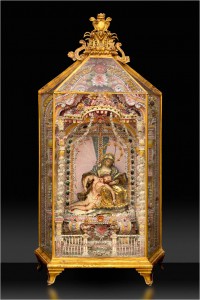What is an Oratory?
An oratory is a structure that offers a setting for prayer. The word comes from the Latin word orare, which means “to pray.” This type of structure (or devotional object) usually contains images of Christ, the Holy Family, or saints and is used for worship outside of church. There are several different kinds of oratories. For example, salon, or private household oratories were located within individual homes.

Our Lady of Piety
Brazilian Oratory
VMFA Photo Resources
Portable or traveling oratories were designed to be placed in small bags. These oratories were often worn by poor beggars—although more elaborate ones were also made for wealthy women. Ark oratories could travel to various locations with priests, while bullet oratories were so named because of their cartridge-like shapes.
Our Lady of Piety was a private oratory made for a wealthy Brazilian. The decorative qualities of this piece reveal not only Rococo and Baroque influences, but also Medieval stylistic traditions such as the wooden carvings that were painted to look life-like.
Our Lady of Piety was bought by Virginia Museum of Fine Arts for its European Art collection as an example of South American art from the colonial period. It embodies various stylistic conventions that were brought over by European colonists, such as the polychrome wood carving of a Pietà scene. It also points to spiritual connections with Europe through the Roman Catholicism brought over by missionaries. This oratory, however, also displays Brazilian stylistic components such as the shells, beetles, and palm tree-like columns.
During transport to VMFA, damage to the oratory created a huge challenge for the conservation department. This damage mostly consisted of the dislocation of many of the small, decorative details, but also included the broken frame and glass of the case.
Click below to learn about Our Lady of Piety in more detail.
Who was Das Conchas?
This oratory was made by Francisco Xavier Dos Santos, commonly known as Das Conchas (which translates as “of the shells”) due to his frequent use of shells in works of art. Our Lady of Piety is a Brazilian Rococo-style oratory from the late 18th century. This oratory is specifically known as a “shell oratorio,” which is a type made primarily by Francisco Xavier dos Santos. It is made using whole shells or shell fragments to create an ornate and lush aesthetic. Not much is known about Dos Santos’ life, but several of his pieces remain in museum collections around the world. For example, another of his oratories is displayed in the Oratory Museum in Brazil, and he is responsible for much of the decorative work in the Church of Our Lady of the Glory of Outeiro in Rio de Janeiro.
Links to Other Pages
Brazilian Oratory: Baroque, Rococo, and Local Influences
Brazilian Oratory: Notes on Brazilian History
Our Lady of Piety Oratory: The Influence of European Religion on South America
Our Lady of Piety Oratory: Condition through the Years
Our Lady of Piety Oratory: Conservation
The Story of How the Beetle got its Colors
Interview with Conservator Sheila Payaqui
Our Lady of Piety: Bibliography